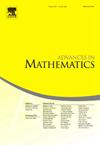伪随机图中的汉密尔顿循环
IF 1.5
1区 数学
Q1 MATHEMATICS
引用次数: 0
摘要
寻找确保图是哈密顿图的一般条件是图论的一个核心课题。该领域有一个古老而著名的猜想,即对于某个通用常数 C>0,任何 d 规则 n 顶点图 G 的第二最大特征值的绝对值 λ(G) 至多为 d/C,则该图具有汉密尔顿循环。在本文中,我们获得了两个主要结果,在解决这一问题上取得了实质性进展。其次,在一般情况下,我们证明了 λ(G)≤d/C(logn)1/3 意味着汉密尔顿循环的存在,从而改进了克里夫列维奇(Krivelevich)和苏达科夫(Sudakov)20 年前提出的 d/log1-o(1)n 约束。我们以一种新颖的方式使用了多种方法,如稳健的波萨旋转扩展技术、带有回滚的弗里德曼-皮彭格树嵌入法和吸收法,并结合了其他工具和思想。我们的结果有几种有趣的应用,特别是它们暗示了目前最著名的关于保证随机 Cayley 图哈密尔顿性的生成器数量的边界,这是众所周知的洛瓦兹哈密尔顿性猜想的一个重要的部分情况。它们还可用于改进阿隆和布尔甘关于乘法子群中加法模式的结果。本文章由计算机程序翻译,如有差异,请以英文原文为准。
Hamilton cycles in pseudorandom graphs
Finding general conditions which ensure that a graph is Hamiltonian is a central topic in graph theory. An old and well-known conjecture in the area states that any d-regular n-vertex graph G whose second largest eigenvalue in absolute value is at most , for some universal constant , has a Hamilton cycle. In this paper, we obtain two main results which make substantial progress towards this problem. Firstly, we settle this conjecture in full when the degree d is at least a small power of n. Secondly, in the general case we show that implies the existence of a Hamilton cycle, improving the 20-year old bound of of Krivelevich and Sudakov. We use in a novel way a variety of methods, such as a robust Pósa rotation-extension technique, the Friedman-Pippenger tree embedding with rollbacks and the absorbing method, combined with additional tools and ideas.
Our results have several interesting applications. In particular, they imply the currently best-known bounds on the number of generators which guarantee the Hamiltonicity of random Cayley graphs, which is an important partial case of the well known Hamiltonicity conjecture of Lovász. They can also be used to improve a result of Alon and Bourgain on additive patterns in multiplicative subgroups.
求助全文
通过发布文献求助,成功后即可免费获取论文全文。
去求助
来源期刊

Advances in Mathematics
数学-数学
CiteScore
2.80
自引率
5.90%
发文量
497
审稿时长
7.5 months
期刊介绍:
Emphasizing contributions that represent significant advances in all areas of pure mathematics, Advances in Mathematics provides research mathematicians with an effective medium for communicating important recent developments in their areas of specialization to colleagues and to scientists in related disciplines.
 求助内容:
求助内容: 应助结果提醒方式:
应助结果提醒方式:


